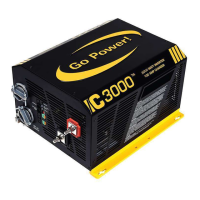gpelectric.com | [page 35]
Corrosion
The IC Series’ AC and DC terminals must be connected to the common boat ground to provide an important safety feature. This
ground connection can introduce the risk of galvanic corrosion and/or electrolysis of the boat’s underwater metallic hardware. A
galvanic isolator or an onboard isolation transformer can be used to prevent galvanic corrosion.
3.7 FINAL INSPECTION
1.
Verify all cables/conduit runs are secured with zip ties or other non-conductive cable clamps to prevent damage from vibration.
2. Ensure all cables that pass-through walls, bulkheads, or any other openings are protected against abrasion by using strain
reliefs and/or grommets.
3. Check all AC, DC and ground connections are securely tightened, and if required, covered with suitable anti-seizing grease.
4. Check the AC terminal connection cover plate has been securely re-attached.
5. Check all connections are secure in the main and sub panels. Replace all covers.
6. If required by code, have the installation inspected by an electrical inspector.
3.8 TESTING THE INSTALLATION
1.
Apply battery power to the inverter by engaging the fuse, switching the breaker on or switching the battery disconnect switch
totheONposition.TheInverter/Chargerwillremaino.
2. DisconnectallACloadsfromthebreakerpanelbyswitchingthemainon/obreakerorallindividualbreakerstotheOFF
position.
3. Press the ON/OFF button. Verify the inverter turns on and its status indicator shows solid green (ON).
4. Turntheinverterothenconnecta25Wlightbulbtotheinverteroutput.Verifythelightcomesonandshinesnormallywhen
the inverter is switched back on. A dim light will indicate a poor AC output. The exact output can be checked at the remote
if installed. The remote should also indicate if the inverter is in Inverting mode by the “INV” symbol in the lower left corner
of the display.
5.
PressandreleasetheON/OFFbuttontoturntheInverter/Chargero,thebulbwillturnoandthestatusindicatorwillturno.
6.
Turn the inverter back on. Note: the inverter must be turned on before shore power is applied. Apply AC shore power (utility
or generator) to the Inverter/Charger. After around 10 seconds the Inverter / Charger will click and the incoming power will be
passed through and the light bulb will turn on. The status indicator on the inverter will be green. The remote should indicate
the inverter is in charge (CHR) mode.
Note:Onceshorepowerisappliedtheinvertercannotbeturnedoasitrequirespowerfromtheinvertertorunthepass-through
modetothetransferswitch.Whenshorepowerisremovedtheinvertercanbeturnedo.
7. Turn on one AC load at the fuse panel and determine if AC is applied to this circuit. If AC is present slowly turn each load
on one by one checking for AC each time.
8.
Disconnect the AC shore power, the light bulb and the inverter should remain on. The light is now being powered by the
Inverter (battery bank). The light bulb can now be removed and the system re-assembled.
Note: the inverter must be turned on before shore or generator power is applied. Also check the “Shore Power Max” setting on
the remote. This will coordinate with the circuit breaker rating from the incoming AC source and ensures any AC loads receive
the maximum current available. For example if plugged into 50 amp service set the ”Shore Power Max” Setting to 50 amps.
3.9 WARNING LABELS
When an Inverter/Charger is installed in a building the National Electrical Code (NEC) requires a label or plaque to be provided.
This label/plaque is required to be easily visible and to inform users of the location of all electrical system disconnects. Buildings
with stand-alone power systems (solar, generator) and utility power must have a permanent plaque or directory providing the
location of both system disconnects.
An Inverter warning label should be installed in a clearly visible location on the breaker panel that is being powered by the Inverter/
Charger. This label is used because it might be falsely assumed that the panel is no longer “live” after the AC Shore Power is
turnedo,whenpowermayactuallystillbeavailablefromtheInverter(batterybank)poweringthesubpanel.
INSTALLATION

